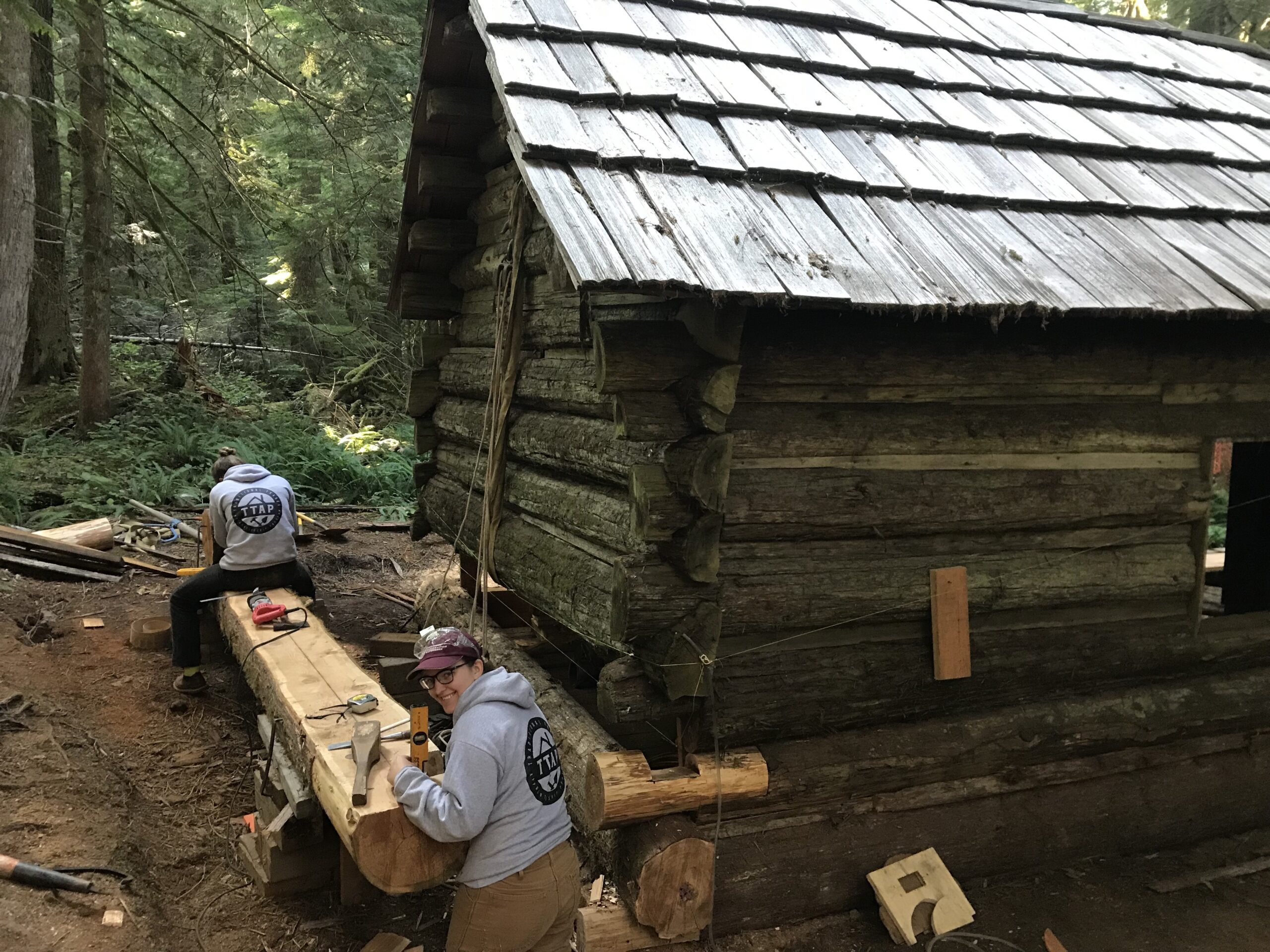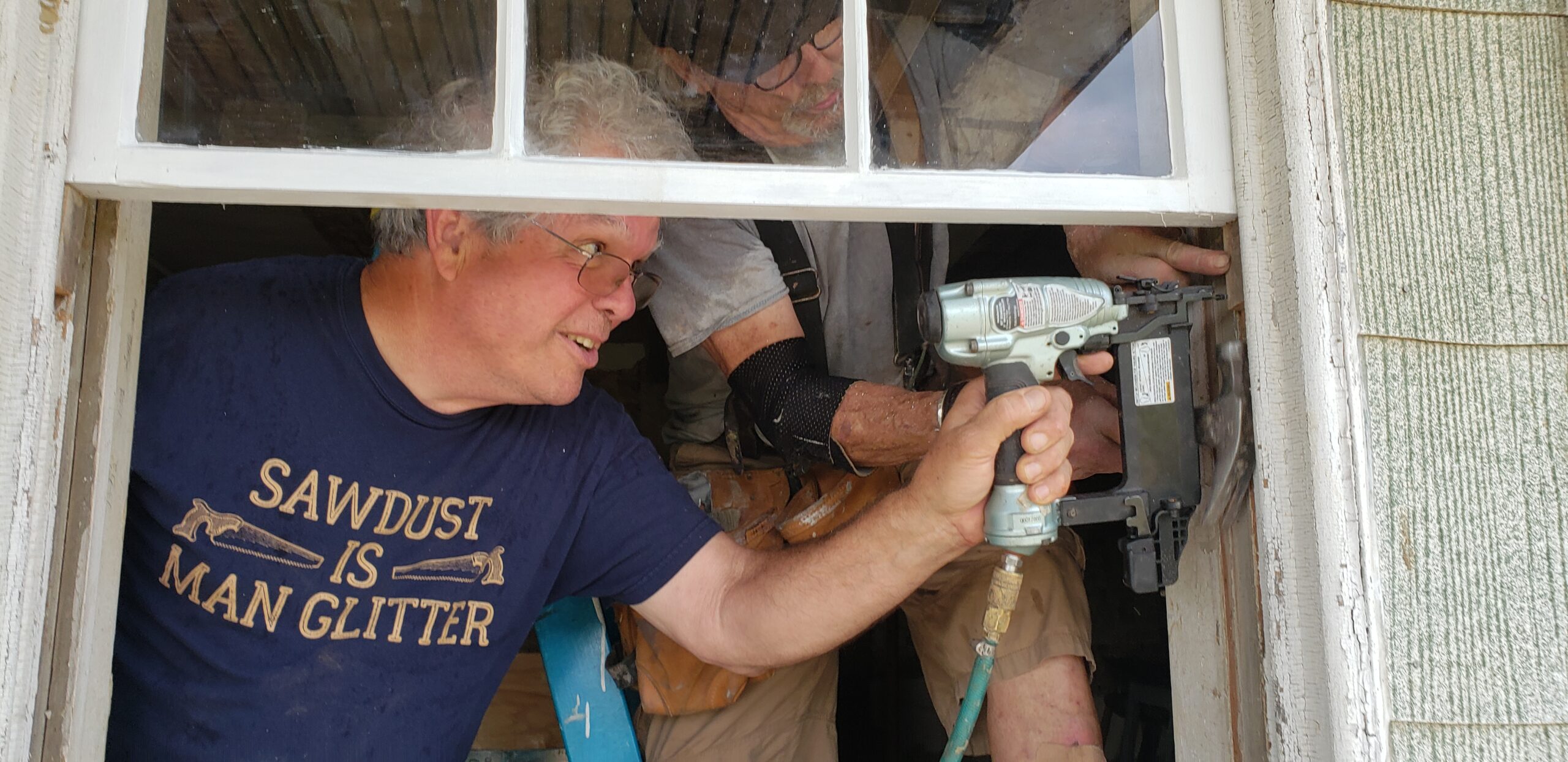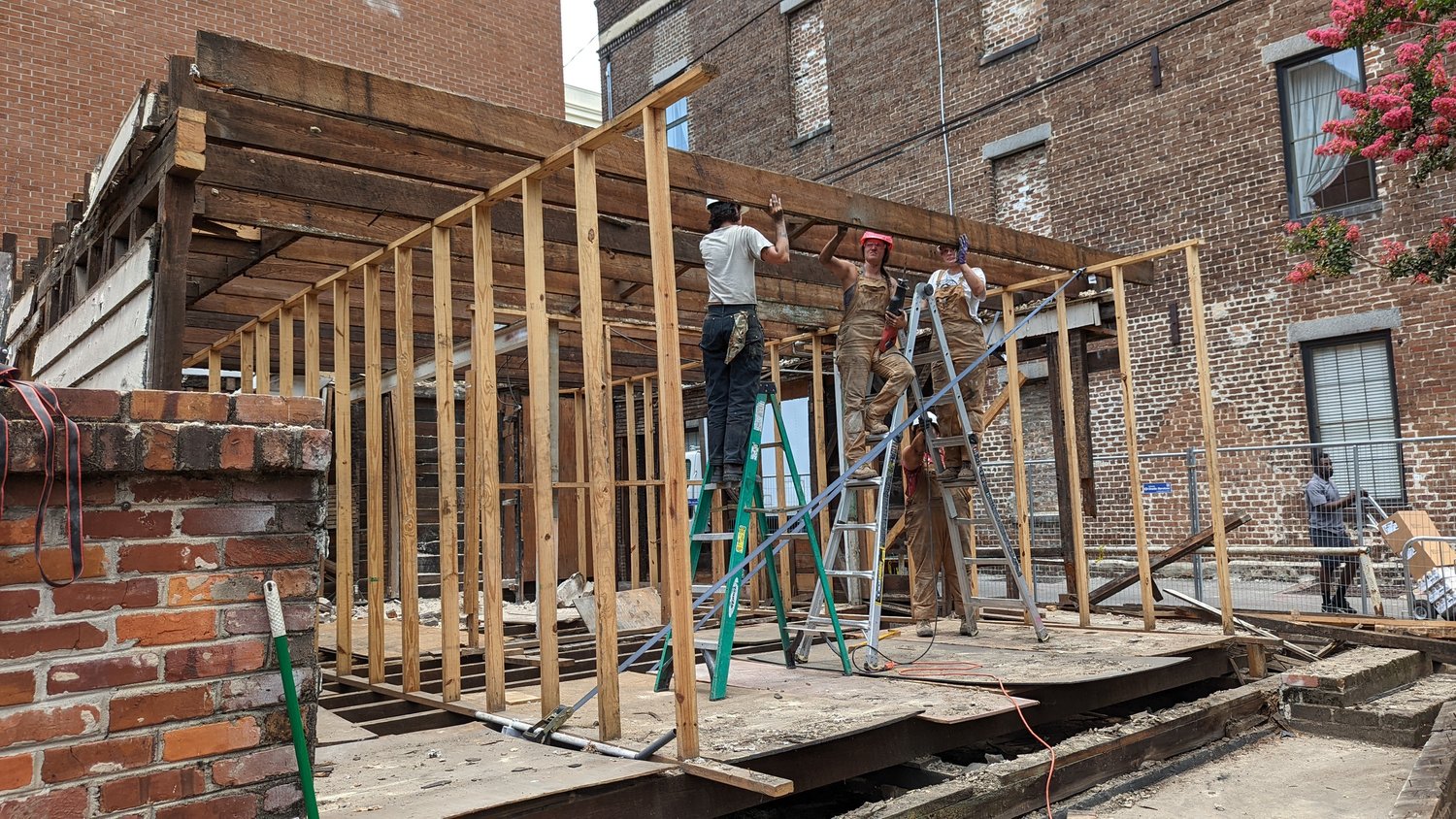HISTORIC TRADES CAREERS
Always Something New
Always Somewhere New
Career Information
Career possibilities in the historic trades are endless. Professionals get to work with their hands, continuously engage with new challenges, and make a difference in the world. Historic tradespeople work with wood, masonry, metal, glass, paints, ceramics, and more. They get to be a part of history, restoring buildings that range from log cabins to the White House. Jobs are available with local, state, and federal governments; non-profits maintaining historic properties; large international businesses restoring castles and palaces; small family-owned businesses helping community members maintain their homes; and ample opportunities to become an entrepreneur and own your own business.
Never settle for boring — a life-long learning and a fulfilling career await. Continue to learn about our current apprenticeship opportunities in:
- Preservation Carpentry
- Historic Window Restoration
- Deconstruction
Preservation Carpenter
Preservation Carpenters reconstruct, restore, and rehabilitate wood structures. They do hands-on work with building elements such as structural framing, rafters, doors, windows, floors, staircases, trusses, beams, interior and exterior trim, and roofing. They use a variety of hand tools like rulers, squares, levels, and hammers; power tools like table saws, circular saws, drills, joiners, and planers; and use work platforms like ladders and scaffolding.
$33
AVERAGE JOURNEY-WORKER HOURLY WAGE
8000
ON-THE-JOB HOURS
600
CLASSROOM HOURS
35,330
NEEDED BY 2030
WAGES
Wages are calculated based on the employer’s average journeyworker rate.
| 0 – 2000 hours | 60% journeyworker rate |
| 2001 – 4000 hours | 70% journeyworker rate |
| 4001 – 6000 hours | 80% journeyworker rate |
| 6001 – 8000 hours | 90% journeyworker rate |
ON THE JOB
Below is an abridged outline of the on-the-job competencies for Preservation Carpenters. Scroll down to find the full Work Process Schedule.
- Historic Preservation Fundamentals – 500 hours
- Document structures and take field measurements.
- Research historic properties.
- Assess the pathology and safety of sites.
- Construction Fundamentals – 1000 hours
- Perform accurate construction math.
- Draft field sketches and production plans.
- Read and understand architectural plans.
- Safety Rules and Practices – 1000 hours
- Safely use hand and power tools.
- Safely lift and carry.
- Set up and use elevated work platforms.
- Wear appropriate PPE.
- Adhere to OSHA safety standards.
- Keep clean and orderly job sites.
- Safely operate heavy equipment.
- Practice appropriate first aid for occupational hazards.
- Building Systems – 3000 hours
- Brace structures.
- Maintain, preserve, restore, reconstruct, rehabilitate, and deconstruct historic and modern flooring systems, staircases, framing, exterior cladding, rafters, decking, trusses, beams, doors, windows, trim, and molding.
- Material Skills – 2000 hours
- Use specialized carpentry tools.
- Compute curves, arcs, and tangents to apply to production plans and material techniques.
- Cut, shape, sand, and clean historic and wooden workpieces.
- Employ a variety of joinery methods to join lumber cuts.
- Maintain, preserve, restore, reproduce, and apply historic and modern decorative finishes.
- Mix and cleanly apply different putties, epoxies, and caulking materials.
- Safely identify and manage hazardous material on site and in the shop.
- Use, select, and substitute proper materials to meet requirements for strength, durability, appearance, and safety.
- Project and Business Management – 500 hours
- Maintain inventories of tools, supplies, and materials.
- Estimate project materials and labor.
- Create schedules and take-offs.
- Create project and business plans.
EDUCATION
- Historic Preservation Fundamentals – 135 hours
- Historic Preservation Fundamentals
- Structural Theory and Pathology
- Historic Research and Documentation
- Architectural History
- History
- Construction Fundamentals – 90 hours
- Math
- Reading and Literacy
- Drafting and Blueprint Reading
- Safety Rules and Practices – 75 hours
- Professional Tool Use and Safety
- OSHA 30
- Leadsafe RRP
- First Aid
- Building Systems – 150 hours
- Windows, Doors, and Millwork
- Carpentry of Buildings
- Roofing
- Framing
- Material Skills – 120 hours
- Wood
- Finishes
- Project and Business Management – 30 hours
- Project and Small Business Management
- Project Estimating
DAY IN THE LIFE
Preservation Carpenters work both indoors and outdoors, on project locations, and in shop spaces.
Preservation Carpenters can work on a variety of project sites – residential, commercial, industrial, and municipal. Some Preservation Carpenters spend most of their time in the field; others spend significant time in the shop performing wood repairs and milling replacement and reproduction; others work with a combination of these. Preservation Carpenters work primarily with lumber, but also work with finishes, putties, epoxies, and fasteners and occasionally with masonry, plaster, and metals as they interact with the wood components of a structure.
In addition to working with their hands, Preservation Carpenters document sites and features, and assess their conditions and pathology. This involves taking photographs, measurements, and understanding building systems and materials. Sometimes, Preservation Carpenters will research historic materials to create repair and reproduction plans.
Preservation Carpenters require skills in creative thinking, problem-solving, time management and safety, and have the ability to make contingency plans and communicate effectively.
YOU MIGHT LIKE PRESERVATION CARPENTRY IF....
You are interested in working with your hands, sustainability, history, circular economies, varied work tasks, and working outdoors.
People who excel in Preservation Carpentry are typically passionate about history, architecture, historic preservation, environmentalism, sustainable building practices, and circular economies. They have keen situational awareness to ensure their team members are safe and healthy. They want a job where they can continuously learn and tackle new challenges with each project. Successful Preservation Carpenters can work independently, anticipate the next steps in a process, adapt to changing conditions, and take initiative.
CAREER OUTLOOK
Preservation Carpentry is a stable industry for residential and commercial work. On average, there are around 3,000 annual job openings for Preservation Carpenters, with expected increases through 2030. There are many opportunities for people to work with private firms and government agencies, explore options with field and shop work, and advance into management for projects and organizations.
- Apprentice starting wage is $19/hour
- Journeyworker starting wage is $33/hour
Historic districts regulate the repair and restoration of historic exteriors. Federally funded projects regulate the interior and exterior work on historic structures. These regulations help ensure a stable industry for this occupation. These occupations cannot be automated, although there may be new technologies that can assist workers and make the jobs safer and easier physically.
Professional development opportunities exist with the Timber Framers Guild and the Preservation Trades Network.
CAREER PROFILE
Learn what it’s like to be a Preservation Carpenter with Amy McAuley, the Preservation Joiner at George Washington’s Mount Vernon.
LEARN MORE
- Organization: Timber Framers Guild
- Video: Preservation Carpentry at North Bennet Street School
- Article: Preservation Brief 45: Preserving Historic Wood Porches
- Try it out: Visit our Opportunities Page
Historic Window Technician
Historic Window Technicians maintain, restore, reconstruct, and deconstruct historic window systems and units. They get hands-on with windows on projects sites and in shop spaces. They use a variety of hand tools like putty knives, hammers, and paint brushes; power tools like drills, planers, and saws; and use work platforms like ladders and scaffolding.
$24
AVERAGE JOURNEY-WORKER HOURLY WAGE
6000
ON-THE-JOB HOURS
450
CLASSROOM HOURS
2,085
NEEDED BY 2030
WAGES
Wages are calculated based on the employer’s average journeyworker rate.
| 0 – 2000 hours | 70% journeyworker rate |
| 2001 – 4000 hours | 80% journeyworker rate |
| 4001 – 6000 hours | 90% journeyworker rate |
ON THE JOB
Below is an abridged outline of the on-the-job competencies for Historic Window Technicians. Scroll down to find the full Work Process Schedule.
- Historic Preservation Fundamentals – 250 hours
- Document structures and take field measurements.
- Research historic properties.
- Assess the pathology and safety of sites.
- Construction Fundamentals – 1000 hours
- Perform accurate construction math.
- Draft field sketches and production plans.
- Read and understand architectural plans.
- Safety Rules and Practices – 500 hours
- Safely use hand and power tools.
- Safely lift and carry.
- Set up and use elevated work platforms.
- Wear appropriate PPE.
- Adhere to OSHA safety standards.
- Keep clean and orderly job sites.
- Safely operate heavy equipment.
- Practice appropriate first aid for occupational hazards.
- Building Systems – 2000 hours
- Maintain, preserve, restore, reconstruct, rehabilitate, and deconstruct historic window operating systems, window boxes, and window sashes.
- Material Skills – 2000 hours
- Fully and partially remove finishes from various substrates.
- Apply different finishes to various substrates following best practices.
- Cut, shape, sand, and clean historic and wooden workpieces.
- Employ a variety of joinery methods to join lumber cuts.
- Cut, shape, buff, and clean historic and modern metals.
- Employ a variety of joinery methods to join metals.
- Cut and clean historic and modern glass.
- Mix and cleanly apply different putties, epoxies, and caulking materials.
- Safely identify and manage hazardous material on site and in the shop.
- Use, select, and substitute proper materials to meet requirements for strength, durability, appearance, and safety.
- Project and Business Management – 250 hours
- Maintain inventories of tools, supplies, and materials.
- Estimate project materials and labor.
- Create schedules and take-offs.
- Create project and business plans.
EDUCATION
- Historic Preservation Fundamentals – 75 hours
- Historic Preservation Fundamentals
- Structural Theory and Pathology
- Historic Research and Documentation
- Architectural History
- History
- Construction Fundamentals – 90 hours
- Math
- Reading and Literacy
- Drafting and Blueprint Reading
- Safety Rules and Practices – 75 hours
- Professional Tool Use and Safety
- OSHA 30
- Leadsafe RRP
- First Aid
- Building Systems – 120 hours
- Windows, Doors, and Millwork
- Carpentry of Buildings
- Weatherization
- Framing
- Material Skills – 60 hours
- Wood
- Finishes
- Metals
- Glass
- Project and Business Management – 30 hours
- Project and Small Business Management
- Project Estimating
DAY IN THE LIFE
Historic Window Technicians work both indoors and outdoors, on project locations, and in shop spaces. Technicians can work on a variety of project sites – residential, commercial, industrial, and municipal. Some Technicians spend most of their time in the field to repair, remove, and reinstall window sashes; others spend significant time in the shop stripping finishes, performing wood repairs, milling replacement pieces, and glazing/refinishing window sashes; others work with a combination of these. Technicians get to work with a variety of materials like wood, metals, glass, putties, epoxies, and finishes.
In addition to working with their hands, Historic Window Technicians document sites and windows, and assess their conditions and pathology. This involves taking photographs, measurements, and understanding building systems and materials. Sometimes, Technicians will research historic operating systems or hardware to create repair plans.
Historic Window Technicians require skills in creative thinking, problem-solving, time management and safety, and have the ability to make contingency plans and communicate effectively.
YOU MIGHT LIKE HISTORIC WINDOW RESTORATION IF....
You are interested in sustainability, mechanics, history, working with your hands, circular economies, varied work tasks, and working outdoors.
People who excel in Historic Window Restoration are typically passionate about history, architecture, historic preservation, environmentalism, sustainable building practices, and circular economies. They have keen situational awareness to ensure their team members are safe and healthy. They want a job where they can continuously learn and tackle new challenges with each project. Successful Technicians can work independently, anticipate the next steps in a process, adapt to changing conditions, and take initiative. The historic window preservation profession values collaboration, so people who foster supportive and encouraging environments will do well in the industry.
CAREER OUTLOOK
Historic Window Restoration is an expanding industry, supported by movements like the Right to Repair and Circular Economies. By 2030, at least 2,000 Historic Window Technicians will be needed for historic tax credit projects. There are many opportunities for people to work with private firms and government agencies, explore options with field and shop work, and advance into management for projects and organizations.
- Apprentice starting wage is $17/hour
- Journeyworker starting wage is $24/hour
Historic districts regulate the repair and restoration of historic windows, as well as on federally-funded projects, so there will always be a need for people to perform this work. These occupations cannot be automated, although there may be new technologies that can assist workers and make the jobs safer and easier physically.
Professional development opportunities exist with the Window Preservation Alliance and the Window Preservation Standards Collaborative, among others.
CAREER PROFILE
Neil Mozer founded Mozer Works Inc. in 2000. Beginning as a builder journeyman, he broadened his skills into historic restoration and in particular, doors and windows. Mozer Works Inc. is one of our Participating Employers.
LEARN MORE
- Organization: Window Preservation Alliance
- Video: How to Repair Window Glass
- Article: All About Historic Windows
- Try it out: Visit our Opportunities Page
Deconstruction Technician
Deconstruction Technicians unbuild structures, salvaging as much viable building material as possible. They get hands-on taking the buildings apart. They use hand tools like sledgehammers and crowbars, power tools like circular saws and hammer drills, and build temporary bracing structures and work platforms like scaffolding.
$18
AVERAGE JOURNEY-WORKER HOURLY WAGE
4000
ON-THE-JOB HOURS
320
CLASSROOM HOURS
2%
PROJECTED JOB GROWTH THROUGH 2033
WAGES
Wages are calculated based on the employer’s average journeyworker rate.
| 0 – 2000 hours | 85% journeyworker rate |
| 2001 – 4000 hours | 90% journeyworker rate |
ON THE JOB
Below is an abridged outline of the on-the-job competencies for Historic Window Technicians. Scroll down to find the full Work Process Schedule.
- Historic Preservation Fundamentals – 400 hours
- Document structures and take field measurements.
- Research historic properties.
- Assess the pathology and safety of sites.
- Construction Fundamentals – 300 hours
- Perform accurate construction math.
- Draft field sketches and production plans.
- Read and understand architectural plans.
- Safety Rules and Practices – 1000 hours
- Safely use hand and power tools.
- Safely lift and carry.
- Set up and use elevated work platforms.
- Wear appropriate PPE.
- Adhere to OSHA safety standards.
- Keep clean and orderly job sites.
- Safely operate heavy equipment.
- Practice appropriate first aid for occupational hazards.
- Building Systems – 1000 hours
- Unbuild a structure, including roofing, walls, masonry, flooring, fenestrations, and mechanical systems.
- Build structural bracing.
- Material Skills – 1000 hours
- Identify viable building materials and pre-process goods for merchandising, including but not limited to denailing, cutting, sorting, and stacking.
- Stack materials for transport on trailers, flatbeds, and pallets.
- Denail and remove defects from lumber.
- Measure, label, and document materials’ provenance.
- Clean mortar from masonry units.
- Stack and merchandise materials in orderly, organized facilities.
- Process salvaged wood into dimensional lumber.
- Cut, shape, sand, and clean historic and wooden workpieces.
- Employ a variety of joinery methods to join lumber cuts.
- Safely identify and manage hazardous material on site and in the shop.
- Project and Business Management – 300 hours
- Maintain inventories of tools, supplies, and materials.
- Estimate project materials and labor.
- Market materials for sale.
- Perform sales and keep accurate accounts of transactions.
EDUCATION
- Historic Preservation Fundamentals – 90 hours
- Historic Preservation Fundamentals
- Structural Theory and Pathology
- Historic Research and Documentation
- Construction Fundamentals – 15 hours
- Drafting and Blueprint Reading
- Safety Rules and Practices – 80 hours
- Professional Tool Use and Safety
- OSHA 30
- Leadsafe RRP
- First Aid
- Building Systems – 90 hours
- Windows, Doors, and Millwork
- Carpentry of Buildings
- Material Skills – 30 hours
- Wood
- Masonry
- Project and Business Management – 15 hours
- Project and Small Business Management
DAY IN THE LIFE
Deconstruction Technicians work outdoors on sites to deconstruct buildings, and some return to indoor shop spaces to process materials. Some shops also have Technicians create new craft goods from salvaged material, using shop tools to create products. Some of these shops will also have a retail branch that interfaces with the public to sell salvaged materials or craft goods.
In addition to working with their hands, Deconstruction Technicians document and research the structure prior to deconstruction. This involves taking photographs, measurements, and using new technologies to create 3D images of spaces. Research can be done through online databases as well as physical archival research with local agencies.
Deconstruction Technicians require skills in situational awareness, teamwork, effective communication, critical thinking, and safety.
YOU MIGHT LIKE DECONSTRUCTION IF....
You are interested in sustainability, history, working with your hands, circular economies, varied work tasks, and working outdoors.
People who excel in Deconstruction are typically passionate about one or more underlying goals of deconstruction (the environment, sustainable building practices, historic preservation, circular economics). They have keen situational awareness to ensure their team members are safe and healthy and are able to assess each project for it’s unique needs. Deconstruction is an emerging industry, so people with an entrepreneurial spirit will find lots of new and exciting opportunities to explore.
CAREER OUTLOOK
Deconstruction is an emerging industry. There are many opportunities for people working with non-profit and for-profit firms, exploring options for field and shop work, and advancing into management for projects and organizations.
- Apprentice starting wage is $15/hour
- Journeyworker starting wage is $18/hour
Local ordinances requiring deconstruction are becoming increasingly common, but the workforce needs to expand to meet this need. These occupations cannot be automated, although there may be new technologies that can assist workers and make the jobs safer and easier physically.
Professional development opportunities exist with Build Re:Use.
CAREER PROFILE
Hear about Deconstruction from Mae Bowley, former director of Re:Purpose Savannah.
LEARN MORE
- Organization: Build ReUse
- Video: https://www.sareuse.com/training
- Article: Deconstruction Overview
- Try it out: Visit our Opportunities Page
There are many ways for individuals, businesses, organizations, and philanthropic groups to support The Campaign. Find out how.



